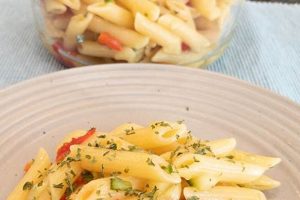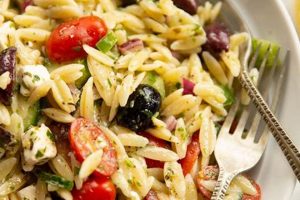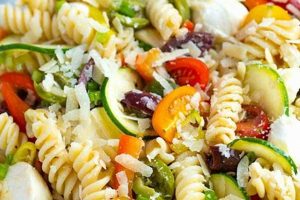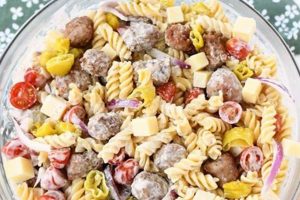A simple pasta salad featuring Italian-inspired ingredients offers a refreshing and customizable dish, often combining cooked pasta, vegetables, cheese, and a vinaigrette dressing. A typical example might include rotini pasta, cherry tomatoes, black olives, mozzarella balls, bell peppers, and a dressing of olive oil, red wine vinegar, garlic, and oregano. Variations can incorporate salami, artichoke hearts, or other preferred ingredients.
Such a salad presents a convenient and versatile meal option, suitable for picnics, potlucks, or light lunches. Its adaptability allows for seasonal variations, accommodating readily available produce and catering to individual preferences. Historically, pasta salads gained popularity as refrigeration became more commonplace, enabling safe storage of prepared dishes. They represent a confluence of Italian culinary traditions with practical modern needs. The relative ease of preparation also makes this type of salad a popular choice for home cooks.
Further exploration of this culinary concept can involve detailed examination of ingredient selection, preparation techniques, dressing variations, and presentation suggestions. Nutritional information and tips for maximizing flavor and freshness will also be addressed.
Tips for a Successful Italian-Inspired Pasta Salad
Optimizing ingredient selection and preparation techniques elevates a simple pasta salad into a flavorful and satisfying culinary experience. Attention to detail ensures optimal texture and taste.
Tip 1: Cook Pasta Al Dente: Pasta cooked slightly firm provides the best texture for salad, preventing a mushy result. Rinsing the cooked pasta in cold water stops the cooking process and helps maintain firmness.
Tip 2: Select High-Quality Ingredients: Fresh, ripe vegetables and flavorful cheeses enhance the overall quality. Using flavorful olive oil and vinegar creates a vibrant dressing.
Tip 3: Balance Flavors: Consider the balance of salty, acidic, and savory components. Salty olives and cheeses complement acidic dressings, while fresh herbs provide an aromatic dimension.
Tip 4: Dress the Salad Shortly Before Serving: Adding the dressing too early can make the pasta absorb too much liquid. This can lead to a less appealing texture.
Tip 5: Marinate Vegetables for Enhanced Flavor: Marinating vegetables such as bell peppers or onions in the vinaigrette before adding them to the pasta intensifies their flavor profile.
Tip 6: Incorporate Fresh Herbs: Fresh herbs like basil, oregano, or parsley add brightness and depth. Adding them just before serving preserves their delicate aroma.
Tip 7: Chill Thoroughly Before Serving: Chilling allows the flavors to meld and enhances the refreshing qualities of the salad. This step is particularly important during warmer weather.
By following these suggestions, one can achieve a pasta salad that is both delicious and visually appealing. The resulting dish offers a delightful combination of flavors and textures.
These tips provide a foundation for creating a satisfying pasta salad experience. Adapting these guidelines to individual preferences allows for a versatile and enjoyable culinary creation.
1. Simple Ingredients
The “easy” in “easy Italian pasta salad recipe” hinges significantly on the simplicity of its core ingredients. Accessibility and ease of preparation are paramount. Common pantry staples like dried pasta, canned olives, and readily available fresh produce like tomatoes and bell peppers minimize shopping efforts and specialized ingredient sourcing. This reliance on uncomplicated components reduces preparation time and culinary expertise required, making the dish achievable for even novice cooks. For example, utilizing pre-shredded mozzarella eliminates a preparation step, further streamlining the process.
Furthermore, the straightforward nature of the ingredients allows for adaptability and substitutions based on individual preferences or dietary needs. Gluten-free pasta can easily replace traditional varieties, while vegan alternatives for cheese or the addition of plant-based proteins cater to specific diets. This inherent flexibility ensures the recipe remains accessible and adaptable, accommodating various culinary needs. Using ingredients like sun-dried tomatoes in oil adds depth of flavor without demanding complex preparation techniques. This exemplifies how simple ingredients can contribute significantly to a dish’s overall flavor profile.
In conclusion, the emphasis on simple ingredients directly contributes to the accessibility and ease of preparation associated with this type of pasta salad. This simplicity not only reduces the barrier to entry for those less experienced in the kitchen but also facilitates adaptation and customization. The use of readily available components ensures the recipe remains practical, affordable, and enjoyable for a broad audience, underscoring the importance of ingredient simplicity in achieving a truly “easy” culinary experience.
2. Quick Preparation
The “quick preparation” aspect is central to the concept of an “easy Italian pasta salad recipe.” It signifies minimal time investment, making the dish appealing for busy individuals or those seeking convenient meal options. Rapid assembly differentiates this type of salad from more elaborate pasta dishes requiring extensive cooking processes or complex techniques.
- Pre-cooked Ingredients:
Utilizing pre-cooked ingredients significantly streamlines preparation. Cooked pasta, canned or jarred vegetables (such as olives, artichoke hearts, or roasted red peppers), and pre-shredded cheese eliminate time-consuming steps. This allows for rapid assembly, aligning with the “quick preparation” premise. This also contributes to the dish’s convenience, making it suitable for impromptu meals or situations where time is limited.
- Simple Techniques:
The recipe typically avoids complex cooking techniques. Boiling pasta and whisking together a simple vinaigrette represent the extent of the culinary skills required. Chopping vegetables is generally the most demanding step. This straightforward approach minimizes preparation time and reduces the potential for culinary missteps, reinforcing the “easy” aspect of the recipe. The lack of elaborate techniques contributes to the accessibility of the dish, regardless of culinary experience.
- Minimal Cooking Time:
Beyond boiling the pasta, minimal cooking is usually required. Some recipes may suggest briefly sauting certain vegetables, but this remains optional. The absence of lengthy cooking processes or complex procedures keeps preparation time short, adhering to the “quick preparation” attribute. This efficiency makes the dish suitable for weeknight meals or occasions where time is a constraint. The minimal cooking requirement also reduces the overall energy consumption associated with preparing the dish.
- Room-Temperature Serving:
While chilling enhances the flavors, many variations can be served at room temperature, further expediting the process. This eliminates the waiting period required for chilling, maximizing the speed of preparation. This adaptability makes the dish particularly suitable for picnics, potlucks, or other situations where refrigeration is unavailable or inconvenient. The flexibility in serving temperature enhances the overall convenience and practicality of the recipe.
These facets collectively contribute to the “quick preparation” characteristic of an easy Italian pasta salad recipe. The emphasis on speed and simplicity underscores the convenience and accessibility of this dish, making it a popular choice for a variety of occasions. The ability to assemble a flavorful and satisfying meal within a short timeframe aligns with contemporary lifestyles and the increasing demand for efficient meal solutions.
3. Versatile Flavors
Versatility of flavor is a defining characteristic of the easy Italian pasta salad recipe. This adaptability stems from the recipe’s inherent capacity to accommodate a broad spectrum of ingredient combinations and flavor profiles, catering to diverse palates and dietary preferences. The foundational componentspasta, a light dressing, and a selection of vegetables and proteinsprovide a neutral canvas, allowing for extensive customization without sacrificing simplicity. This characteristic distinguishes the dish from recipes with more rigid structures and prescribed flavor combinations.
Several factors contribute to this inherent versatility. The neutral flavor of most pasta varieties readily absorbs the flavors of accompanying ingredients, whether a tangy vinaigrette, savory cheeses, or the subtle sweetness of roasted vegetables. The dressing, often a simple vinaigrette, acts as a unifying element but can be easily modified to incorporate different herbs, spices, or citrus elements. The choice of vegetables and proteins offers further opportunities for customization. A classic Italian combination might include olives, mozzarella, and salami, while a Mediterranean variation might incorporate feta cheese, artichoke hearts, and sun-dried tomatoes. This adaptability extends to seasonal variations, allowing for the incorporation of readily available fresh produce. For example, summer versions might feature fresh basil, tomatoes, and zucchini, while autumn versions could incorporate roasted butternut squash and pumpkin seeds.
The practical significance of this flavor versatility is substantial. It allows the recipe to transcend individual preferences and dietary restrictions, broadening its appeal and utility. Vegetarian adaptations are easily achieved by omitting meat and incorporating plant-based proteins or additional vegetables. Gluten-free versions can be created using gluten-free pasta. This inherent adaptability not only simplifies meal planning but also facilitates inclusive dining experiences, catering to diverse needs without requiring significant recipe alterations. Furthermore, the ability to customize flavors encourages culinary exploration and personalization, empowering individuals to create variations aligned with specific tastes and preferences. This fosters a sense of culinary ownership and creativity, transforming a simple pasta salad into a personalized culinary expression.
4. Customizable Options
Customization is integral to the appeal of an easy Italian pasta salad recipe. Its adaptable nature allows for variations catering to individual preferences, dietary needs, and available ingredients. This flexibility distinguishes the dish from recipes with fixed ingredient lists and procedures, enhancing its utility and appeal across diverse culinary contexts.
- Dietary Adaptations
Dietary restrictions pose no barrier to enjoying this versatile dish. Vegetarian versions easily omit meat, incorporating alternatives like chickpeas or white beans for protein. Vegan adaptations utilize plant-based cheeses and ensure the dressing contains no animal products. Gluten-free pasta seamlessly substitutes traditional pasta, catering to gluten sensitivities. These adaptations showcase the recipe’s inclusivity, enabling participation across a wide range of dietary requirements.
- Ingredient Swaps
The flexible nature of the recipe encourages ingredient substitutions based on preference or availability. Swapping vegetables like bell peppers for cucumbers or cherry tomatoes for sun-dried tomatoes provides variety without compromising the dish’s essence. Different cheeses, such as provolone or feta, can replace mozzarella, introducing new flavor profiles. These substitutions highlight the recipe’s adaptability, empowering individuals to tailor the dish to specific tastes and available resources.
- Seasonal Variations
Seasonal produce enhances the pasta salad’s flavor and nutritional value. Spring versions might include asparagus and fresh peas, while summer iterations feature ripe tomatoes and basil. Autumnal variations incorporate roasted butternut squash or pumpkin, and winter versions may use Brussels sprouts or kale. These seasonal adaptations reflect the recipe’s responsiveness to ingredient availability, maximizing freshness and flavor throughout the year.
- Protein Choices
Protein additions contribute to the salad’s heartiness and nutritional profile. Traditional Italian meats like salami or prosciutto offer savory depth. Seafood options like shrimp or flaked tuna create lighter variations. Grilled chicken or tofu provide lean protein alternatives. These diverse protein choices demonstrate the recipe’s versatility, catering to varied tastes and nutritional goals.
The customizable nature of the easy Italian pasta salad recipe contributes significantly to its enduring popularity. Its adaptability extends beyond individual preferences, encompassing dietary needs and seasonal ingredient availability. This inherent flexibility positions the dish as a practical and enjoyable meal option for diverse contexts, solidifying its place as a culinary staple.
5. Refreshing Taste
The refreshing taste of an easy Italian pasta salad contributes significantly to its appeal, particularly during warmer months. This quality distinguishes it from heavier, richer pasta dishes, positioning it as a light and invigorating meal option. The sense of refreshment derives from a combination of factors, primarily chilled temperature, vibrant flavors, and textural contrasts. These elements work synergistically to create a palatable and revitalizing culinary experience.
- Chilled Temperature
Serving the salad chilled enhances its refreshing quality. Cold pasta and vegetables provide a welcome contrast to warm weather, contributing to a cooling sensation. This characteristic makes the dish particularly appealing during summer months or in warmer climates. The chilled temperature also helps to preserve the freshness of the ingredients, contributing to a more vibrant overall taste.
- Vibrant Flavors
The combination of fresh vegetables, tangy vinaigrette, and often salty cheeses or cured meats creates a vibrant flavor profile. The acidity of the vinaigrette, often incorporating ingredients like lemon juice or vinegar, further enhances the refreshing quality. The interplay of these flavors stimulates the palate, offering a lively and invigorating taste experience. Herbs like basil or oregano also contribute to the refreshing flavor profile.
- Textural Contrasts
The contrasting textures of firm pasta, crisp vegetables, and potentially creamy cheese or chewy meat create a multi-sensory experience. This textural variety adds to the overall enjoyment and contributes to the perception of freshness. The interplay of textures prevents the dish from feeling monotonous, enhancing its appeal. The al dente texture of the pasta is particularly important in maintaining this textural contrast.
- Light and Digestible Nature
Compared to heavier pasta dishes with creamy sauces, the easy Italian pasta salad is typically lighter and more easily digestible. The absence of heavy cream or cheese-based sauces contributes to this characteristic. The lighter nature of the dish aligns with the desire for refreshing meals, particularly in warmer weather, offering a less weighty and more revitalizing option. The refreshing quality also stems from the often-smaller portion sizes compared to heavier pasta meals.
These elements collectively contribute to the refreshing taste profile of the easy Italian pasta salad, distinguishing it from other pasta dishes and solidifying its appeal as a light, invigorating meal option. The combination of chilled temperature, vibrant flavors, textural contrasts, and a light, digestible nature creates a culinary experience that is both satisfying and revitalizing, particularly in warmer climates or during summer months. The refreshing quality underscores the dishs versatility and suitability for casual dining occasions.
6. Make-Ahead Convenience
The “make-ahead convenience” associated with easy Italian pasta salad recipes significantly contributes to their practicality and appeal. This attribute allows for advanced preparation, reducing time constraints surrounding mealtimes and enhancing the dish’s suitability for various occasions, from potlucks to busy weeknight dinners. The ability to prepare the salad in advance distinguishes it from dishes requiring immediate consumption, offering flexibility and efficiency in meal planning and execution.
- Time Optimization
Preparing the pasta salad ahead of time optimizes time management, particularly beneficial for busy schedules. Completing the recipe hours or even a day in advance frees up valuable time closer to mealtime. This aspect allows individuals to focus on other tasks or simply relax without the pressure of last-minute meal preparation. This time-saving element enhances the overall ease and convenience associated with the recipe.
- Flavor Enhancement
Making the salad ahead of time allows the flavors to meld and intensify. The marinating process enhances the absorption of the vinaigrette into the pasta and vegetables, creating a more cohesive and flavorful dish. This flavor development distinguishes make-ahead pasta salads from those assembled immediately before serving, offering a more robust and complex taste profile.
- Simplified Serving
Pre-made pasta salad simplifies serving, especially for gatherings or potlucks. Transporting a prepared dish eliminates the need for on-site assembly, reducing stress and logistical challenges. This aspect increases the dish’s portability and suitability for various social events, further contributing to its convenience. The ease of serving enhances the overall practicality of the recipe for entertaining or large group meals.
- Reduced Food Waste
Preparing pasta salad in advance can contribute to reduced food waste. Utilizing leftover cooked pasta or vegetables in the salad repurposes ingredients that might otherwise be discarded. This aligns with economical and sustainable food practices, maximizing the utilization of available resources. The ability to incorporate leftover ingredients enhances the recipe’s value and practicality, reducing both waste and grocery costs.
The make-ahead convenience inherent in easy Italian pasta salad recipes enhances their appeal as a practical and versatile meal option. Time optimization, flavor enhancement, simplified serving, and the potential for reduced food waste collectively contribute to the dish’s efficiency and suitability for a wide range of occasions and lifestyles. This characteristic aligns with contemporary demands for convenient and adaptable meal solutions, solidifying the pasta salad’s place as a culinary staple.
Frequently Asked Questions
This section addresses common inquiries regarding easy Italian pasta salad recipes, providing concise and informative responses to clarify potential uncertainties and offer practical guidance.
Question 1: What type of pasta is best suited for Italian pasta salad?
Shorter pasta shapes like rotini, farfalle, penne, or fusilli work well, as they hold the dressing effectively and are easy to eat. Longer pasta varieties can be used but may require breaking into smaller pieces.
Question 2: Can the dressing be made in advance?
Vinaigrette dressings can be prepared in advance and stored separately. Adding the dressing to the pasta too early can cause it to become overly saturated. It is generally recommended to dress the salad shortly before serving.
Question 3: How long can Italian pasta salad be stored?
Properly stored in an airtight container in the refrigerator, Italian pasta salad typically lasts for three to five days. Discard any salad showing signs of spoilage.
Question 4: How can one prevent the pasta salad from becoming dry?
Adding a small amount of reserved pasta water to the salad before mixing helps prevent dryness. The starchy water creates a light coating on the pasta, helping it retain moisture and absorb the dressing more effectively.
Question 5: What are some suitable vegetarian protein options?
Chickpeas, cannellini beans, or cubed firm tofu offer excellent vegetarian protein sources. These ingredients complement the flavors of the salad while contributing to a more balanced nutritional profile.
Question 6: Can frozen vegetables be used?
While fresh vegetables are generally preferred for optimal texture and flavor, frozen vegetables can be used in a pinch. Ensure they are fully thawed and patted dry before incorporating them into the salad to prevent excess moisture.
Understanding these common points of inquiry helps ensure successful preparation and enjoyment of easy Italian pasta salads. These responses provide practical guidance for navigating recipe variations and optimizing outcomes.
The following section will explore variations on the classic Italian pasta salad recipe, offering inspiration for customization and adaptation.
Easy Italian Pasta Salad Recipe
Exploration of the “easy Italian pasta salad recipe” reveals a dish characterized by simplicity, versatility, and adaptability. Key attributes include readily available ingredients, minimal preparation time, customizable flavors, and a refreshing taste profile. The convenience of make-ahead preparation further enhances its practicality for various occasions. Dietary adaptations are readily achieved, accommodating diverse nutritional needs and preferences. Examination of core componentspasta, vegetables, dressing, and optional proteinshighlights the recipe’s inherent flexibility and potential for personalized variations. The historical context and cultural influences contribute to its enduring popularity as a culinary staple.
The “easy Italian pasta salad recipe” transcends its seemingly simple nature, representing a versatile and adaptable culinary concept. Its enduring appeal stems from the ability to cater to individual tastes and dietary requirements while requiring minimal culinary expertise. Continued exploration of flavor combinations and ingredient variations ensures its relevance within a dynamic culinary landscape. The recipe’s adaptability positions it as a valuable and enduring element of contemporary cuisine.






